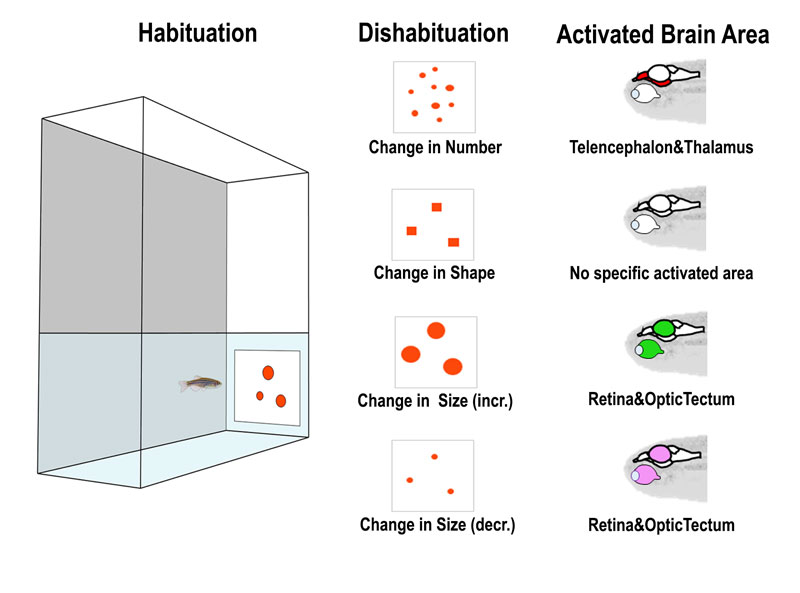In order to investigate the neural correlates of numerosity assessment, separate groups of zebrafish underwent a habituation procedure in which they were repeatedly presented with a set of three or nine small red dots (numerosity), associated with a food reward. Subsequently, zebrafish were exposed to a novel stimulus (dishabituation test) that could change in numerosity, shape or size. A control group was presented with the same stimulus as in the habituation phase. Our results revealed that the telencephalon and thalamus exhibited the most consistent modulation of neural activity upon change in numerousness compared to the control group; in contrast, the retina and optic tectum responded mainly to changes in stimulus size.

Figure: Schematic representation of the behavioral task used in the habituation/dishabituation task. In the habituation phase, zebrafish were exposed to a set of stimuli with a certain numerosity (i.e., 3 or 9 dots). During the subsequent dishabituation test, zebrafish faced a change (i) in number (from 3 to 9 or vice versa with the same overall surface area), or (ii) in shape (with the same overall surface and number), or (iii) in size (with the same shape and number). A control group of zebrafish was shown the same stimuli as during the habituation.
The ability to evaluate numerical information represents an ecological advantage in the interactions between organisms and their surrounding environment. Animals exploit this ability to optimize foraging decisions, responses to aggression, defense and predation, or to estimate the number of social companions. Numerical abilities have been documented in a variety of species, in different taxonomic groups such as mammals, amphibians, reptiles, birds, fish and insects.
Although numerical abilities are widespread in non-human animals, data concerning their neural bases are confined to non-human primates and corvids. Nieder and collaborators discovered populations of neurons selectively sensitive to number in the endbrain of numerically-naive corvids and in the parietal cortex of non-human primates. A role for the posterior part of the parietal cortex in number cognition has been documented in humans using functional Magnetic Resonance Imaging techniques.
It has been shown that even species more evolutionary distant to humans, such as fish, possess numerical abilities. However, the neurological and molecular bases of these skills are largely unknown in fish. We thus decided to investigate the neural basis of numerical abilities in zebrafish (Danio rerio), which is one of the most extensively used animal models in biology. We checked for the neural activity of different macro-compartments of the zebrafish brain (telencephalon, thalamus, optic tectum, retina, cerebellum and medulla oblongata) during a habituation/dishabituation task designed to assess numerical abilities. As a marker of neural activity, we used the expression of immediate early genes, a set of genes primarily transcribed in activated neurons. We found that the telencephalon and the thalamus represent the two main numerousness-responsive macro-compartments in the zebrafish brain. In contrast, the retina and optic tectum seem mainly involved in the processing of changes in stimulus size, i.e. with continuous rather than discrete estimation of quantity. No changes in neural activity were detected in the cerebellum and medulla oblongata in any of the tested conditions.
Taken together, our results suggest that the telencephalon and the thalamus could be the major regions involved in quantity and number discrimination in zebrafish. The results are in agreement with findings that showed an involvement of telencephalic areas linked to number representation in humans, non-human primates and corvids.
Our findings open up the possibility to use zebrafish as an animal model to study the neural correlates of quantity discrimination in vertebrates and to investigate, for the first time, intellectual disabilities linked to numerousness assessment in humans such as developmental dyscalculia.


































